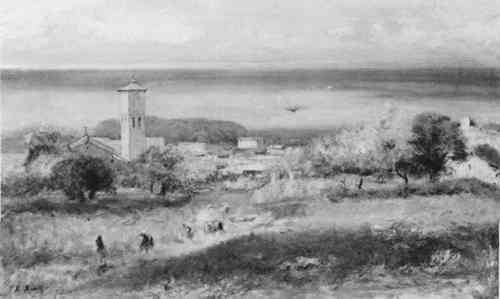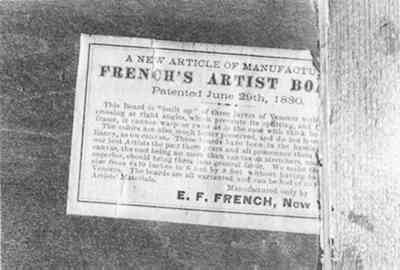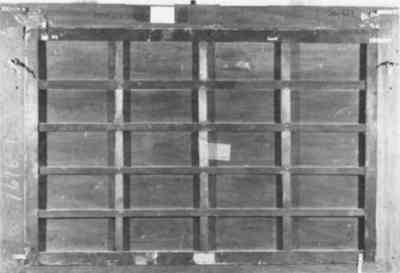AN EARLY EXAMPLE OF A PLYWOOD SUPPORT FOR PAINTINGMULLER NORMAN E.
ABSTRACT—A painting of Albano, Italy by George Inness in The Art Museum, Princeton University, was found upon examination to be painted on a plywood panel manufactured by E. French of New York City around 1880. A brief history of the development of plywood is presented. The Inness painting is one of the earliest examples of this type of support, which dates to shortly after 1880. Those who work on 19th-century American paintings have come to expect a limited variety of supports, ranging from linen and cotton ticking to expensive clear pine and mahogany. Few, perhaps, have ever encountered plywood or even thought that such a material was available to the late 19th-century artist. Yet just that type of support was found for a painting of Albano, Italy, by the American artist George Inness, in the collection of The Art Museum of Princeton University (fig. 1). The painting is signed but not dated. Its style and subject matter had led some to date it to the artist's third trip to Italy(1872-74), which he cut short because of problems with his Boston dealers, Williams and Everett. Upon his return to the United States early in 1875, Inness went directly to Boston to secure a business arrangement with Doll and Richards, who became his new dealers (Cikovsky 1971). In Boston he began to compose works of American and Italian subjects, implying by the latter that he worked from sketches made during his European trip. In the catalogue raison�e of the artist's work, by LeRoy Ireland (1965), the support of the Princeton painting was called a cradled panel. This designation, hardly one to arouse one to curiosity, was not questioned until the painting was examined before its cleaning in 1988. When the painting was turned over, in the center of the panel and partially obscured by a small fixed cradle member, was a paper label (fig. 2) that read:
Little is known about Evelyn F. French. A patent on his artist's board, kindly supplied to the author by Alexander Katlan, states that the patent application was filed on August 6, 1878, and the patent received on June 29, 1880. In his patent justification French explained that the cross-grain gluing of the veneers would keep the board dimensionally stable even if it were subjected to extremes of temperature and humidity. As a preventive measure, though, a perimeter frame of pine was glued to the reverse (fig. 3). The frame on the Inness is of 4.1 � 1.3 cm pine stock and has half-lap corners. Later, a grid of smaller pine strips was glued within the frame.The grid accounts for the small batten strip that obscures a portion of the French label. As a final preparation before the panel was sold, the surface was presumably primed with white lead in oil, as mentioned in his patent justification.
Inness' use of a plywood support coincides closely with its introduction as a new, inexpensive commercial product with wide appeal. Although the practice of gluing strips of thin veneers cross grain to a thicker board had a fairly long history, as witnessed by the decorative examples in fine furniture of the 18th century, obtaining wide sheets of veneer was not possible until the development of veneer slicers before 1875 (Perry 1942). Earlier, the first distinctive veneer-cutting machine was the turning lathe, invented by John Dresser of Stockbridge, Massachusetts; Dresser obtained a patent for it in 1840. At least two decades elapsed before the economic possibilities of this machine were realized. Then, quite suddenly, there was a proliferation of “veneered wood,” The United states was not the first country to manufacture plywood. In 1830, a full four decades before plywood began to be commercially available in this country, Michael Thonet, a cabinet maker from Boppard-am-Rhein, a small town in northern Germany just south of Koblenz, was making steam-bent plywood chairs to wide acclaim (Pevsner 1939). Before his work was exhibited at the Crystal Palace in London in 1851, plywood was beginning to be commercially produced for artists. A three-ply support, 66 � 50 � 1.2 cm, bearing an oval “Durand-Ruel, Rue de la Paix 1, Paris” stencil on the reverse, was bought by Eugene L.G. Isabey and used for his composition The Departure of Elizabeth of France for Spain, now in the Judging from the Inness painting in The Art Museum, which is in generally good condition with only a slight convex warp across the grain, plywood was a sensible alternative to heavier and more expensive wood supports. In many years of treating paintings I have come across only this one example, and I have recently learned of another: a privately owned painting by Fanny Gifford of waterfowl, measuring 50.8 � 35.6 cm. Plywood may have remained a rather exotic product among artists, and whether anyone ever bothered to paint on a plywood support measuring 6 � 8 ft must remain mere speculation. Inness' Albano, Italy is a marvelous example of his late style, painted with free, crisp, impressionistic brushwork, without the sensitive bituminous and resinous paints that characterize his romantic landscapes of the mid-1880s and 1890s. It could very well be that Inness was one of those “best Artists” who were given examples of French's Artist Board to try three years before the patent was issued and decided to continue using the product after it was available commercially. In any event, the work in question should date a little after 1880. The little label on the back of the painting should serve to caution every researcher about drawing conclusions based on an incomplete examination of a painting, especially that of the side that usually faces the wall. ACKNOWLEDGEMENTSI wish to thank Melanie Gifford, conservator at the Walters Art Gallery, Baltimore, who brought to my attention early European examples of plywood; and Alexander Katlan, a New York conservator, who provided me with information on Evelyn French and the painting by Fanny Gifford. REFERENCESCikovsky, N., Jr.1971. George Inness. New York:Praeger. Ireland, L.1965. The works of George Inness. Austin, Tex.: University of Texas Press. Johnston, W.R.1982. The nineteenth-century paintings in the Walters Art Gallery. Baltimore, Md.: Trustees of the Walters Art Gallery. Perry, T.1942. Modern plywood. New York: Pitman Publishing Corp. Pevsner, N.1939. The history of plywood. The Architectural Review86:129–30. Wood, A.1963. Plywoods of the World. Edinburgh and London: W. and A. K. Johnston. AUTHOR INFORMATIONNORMAN E. MULLER was graduated from the Conservation Center of the Institute of Fine Arts, New York University, and has been employed as a paintings conservator by a number of major museums in the United States. At present he is a conservator at The Art Museum, Princeton University. He has lectured and published widely on American and early Italian painting materials and techniques. Address: The Art Museum, Princeton University, Princeton, N.J. 08544.
 Section Index Section Index |


